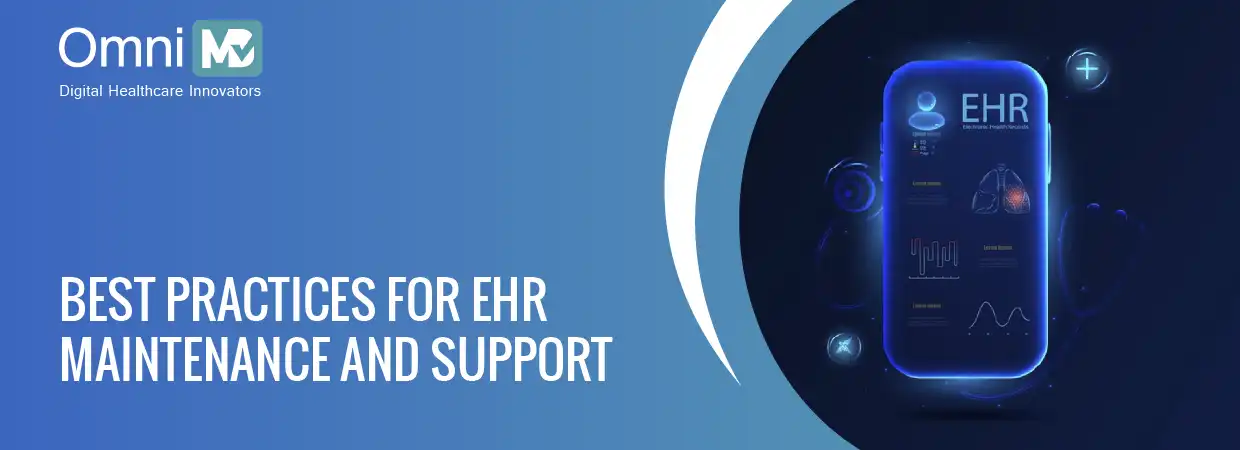How to Avoid Downtime: Best Practices for EHR Maintenance and Support
Simply put, EHR downtime is when the system is entirely or partially unavailable. This can happen due to a severe storm, network issues, human errors, or even malicious cyberattacks.
In a healthcare setting, when the EHRs, which act as the central hub of patient care, fail, they halt the entire hospital’s operations, creating significant risks for both patients and staff.
Financially, the hospitals are reported to lose an average of $ 25,000 per minute due to EHR downtime. Regarding patient care, a study highlights that lab test results are delayed by about 62% during unexpected EHR disruptions.
To add to the complexity, compliance issues make things worse. When sensitive data is compromised, it leads to HIPAA violations and fines reaching up to $50,000 per violation.
Thus, to help you minimize the impact of downtimes and ensure continuous, high-quality patient care, we will explore the best EHR maintenance practices in this article.
Let’s begin.
Avoiding EHR disruptions: Preparation and Planning Before Downtime
Ensuring your organization is ready for EHR downtime goes beyond simply having a plan, it’s about establishing a safety net that guarantees continuous patient care and operational stability. No doubt system failures can bring significant challenges, but with proactive measures, you can minimize disruptions and keep everything running smoothly. Here’s how.
1. Establish a downtime planning team
Why it’s important: Having a dedicated team ensures every department is ready to handle a downtime situation. It’s like having a special task force that knows exactly how to act when the unexpected happens.
What to do:
- Form a team with IT experts, clinical staff, and hospital administrators.
- Assign roles for tasks like staff training, communication, and supply management.
How it helps: The University of Vermont Health Network’s experience with a ransomware attack in 2020 highlights the importance of coordination during crises. Their efforts to restore systems while continuing critical medical care demonstrate how a well-prepared team can help mitigate disruption, even in severe scenarios.
2. Regularly review and update downtime procedures
Why it’s important: EHR downtime procedures must stay relevant as hospital workflows and technologies evolve. Regular updates prevent confusion and ensure everyone is on the same page regarding EHR downtime prevention.
What to do:
- Review paper forms, workflows, and backup equipment periodically.
- Get frontline staff involved in identifying gaps.
- Ensure updated processes are approved by relevant departments.
How it helps: The Mayo Clinic has emphasized improving downtime processes to enhance reliability and client outcomes. This approach ensures that organizations can adapt to evolving workflows and compliance standards.
3. Plan for extended downtime
Why it’s important: Not all downtimes are brief; extended disruptions require carefully planned alternatives to ensure the progression of critical services.
What to do:
- Identify services to prioritize and those that can be temporarily paused.
- Develop manual workflows for essential tasks like admissions and medication orders.
- Communicate clear plans to staff and patients.
How it helps: In October 2020, the University of Vermont Health Network experienced a ransomware attack that led to a month-long EHR downtime. They implemented hand-operated tasks and prioritized urgent care services, ensuring clinical care regularity during this extended system outage.
4. Set up downtime workstations
Why it’s important: Dedicated areas equipped for non-digital operations help teams adapt quickly during downtimes.
What to do:
- Designate specific areas for downtime operations.
- Stock these stations with paper forms, printers, and secure storage for patient information.
- Provide detailed workflow guides.
How it helps: Massachusetts General Hospital provides a structured guide to help healthcare facilities prepare effectively, emphasizing readiness for unplanned downtime events. Though the toolkit was published in 2018, it remains highly relevant due to its forward-thinking approach and established reputation.
5. Prepare supplies and train staff
Why it’s important: Ensuring staff know how to handle unautomated systems during downtime prevents delays and errors.
What to do:
- Stock supplies like downtime forms, labels, and patient wristbands.
- Train staff on paper charting and other manual workflows.
- Conduct downtime drills regularly to test readiness.
How it helps: The Medical Group Management Association (MGMA) highlights that effective protocols, including staff training and preparedness, are crucial for maintaining mechanisms during EHR outages. Their insights stress the need for regular drills and updated instructions to handle disruptions efficiently.
6. Secure critical information
Why it’s important: Access to critical patient and operational data during downtime ensures continuity of care.
What to do:
- Back up vital data regularly to secure offline locations.
- Maintain printed copies of essential information like staff schedules and contact lists.
- Ensure backups are securely stored and easily accessible.
How it helps: Mayo Clinic has implemented measures to protect information during system downtimes. Their approach includes regular backups and maintaining offline copies of critical data to ensure availability during emergencies.
During Downtime: EHR Support Strategies
When EHR systems go offline, maintaining order amidst disruption becomes paramount. With well-practiced protocols, clear communication channels, and adaptable structures, your healthcare teams can swiftly address priorities, reduce delays, and ensure that patient safety remains uncompromised during downtime. Here’s how the same can be achieved.
1. Communicate clearly and quickly
Why it’s important: Clear communication prevents confusion among staff and ensures smooth task flow.
What to do:
- Notify all departments immediately using predefined channels (email, overhead announcements, etc.).
- Assign communication ‘runners’ to share updates manually if digital systems are down.
How it helps: During system outages, hospitals have employed backup communication solutions to ensure the continuity of patient services. For instance, some hospitals use tickers on intranet pages, maintain directories of phone numbers for ‘phone tree’ communications, and keep walkie-talkies available for use when digital systems fail.
2. Prioritize critical services
Why it’s important: During downtime, it’s essential to focus on life-saving and high-priority services.
What to do:
- Shift resources to emergency and critical care units.
- Defer elective procedures and outpatient services if necessary.
How it helps: During the Scripps Health ransomware attack, electronic health records and imaging systems were encrypted, forcing clinicians to revert to mechanical routines. This situation necessitated the prioritization of emergency and critical care services to manage care delivery effectively.
3. Use downtime tools and resources
Why it’s important: Having the right tools and resources available ensures frameworks can be kept up manually.
What to do:
- Deploy downtime carts equipped with paper forms, medication lists, and patient tracking tools.
- Utilize printed protocols and quick-reference guides for critical workflows.
How it helps: Cleveland Clinic’s focus on customized crash carts demonstrates how thoughtfully prepared resources can enhance patient safety and efficiency in emergencies.
4. Maintain patient safety
Why it’s important: Ensuring patient safety during EHR downtime is the top priority.
What to do:
- Implement double-check systems for medication orders and high-risk procedures.
- Use visual aids like color-coded wristbands or labels to minimize errors.
How it helps: Implementing standardized color-coded syringe labels has been shown to enhance patient safety by reducing medication errors. Also, the American Society of Anesthesiologists (ASA) has issued a statement on the labeling of pharmaceuticals for use in anesthesiology, emphasizing the importance of standardized color-coded labels to reduce medication errors and enhance patient safety.
After Downtime: EHR Backup and Recovery
Today, post-downtime recovery has become all about bouncing forward. By reflecting on the downtime experience, reconciling data, and identifying improvement areas, healthcare organizations can transform challenges into actionable insights. Here’s how.
1.Reconcile Data and Documentation
Why it’s important: Ensuring all manually documented data is correctly entered into the EHR system is critical for accuracy.
What to do:
- Assign staff to review and input paper records into the EHR.
- Double-check entries to avoid data mismatches or omissions.
How it helps: Massachusetts General Hospital emphasizes the importance of data reconciliation post-downtime to maintain patient safety and care consistency.
2. Analyze Downtime Performance
Why it’s important: Identifying what worked and what didn’t helps improve future downtime responses.
What to do:
- Hold debrief sessions with all departments to discuss challenges.
- Document lessons learned and update downtime procedures accordingly.
How it helps: Boston Children’s Hospital documented lessons from previous downtime scenarios, demonstrating how continuous evaluation helps refine protocols and address key areas for improvement, such as communication
3. Conduct Staff Training Based on Lessons Learned
Why it’s important: Ongoing training ensures staff are prepared for future downtimes.
What to do:
- Incorporate lessons from the recent downtime into training programs.
- Conduct regular simulations to reinforce best practices.
How it helps: Baylor St. Luke’s Medical Center implemented an EHR downtime readiness and recovery plan, resulting in improved staff preparedness for both scheduled and unscheduled downtimes.
4. Strengthen IT and Cybersecurity Measures
Why it’s important: Preventing future downtimes requires robust IT infrastructure and cybersecurity protocols.
What to do:
- Update firewalls, antivirus software, and backup systems regularly.
- Conduct vulnerability assessments to address weaknesses.
How it helps: Sutter Health System developed comprehensive downtime procedures to ensure business continuity and rapid recovery in the event of IT disruptions.
The OmniMD Edge
While preparation and planning are critical to mitigating the effects of downtime, the best solution is often to avoid downtime altogether.
That’s where we, OmniMD, stand out. Our EHR software boasts an impressive uptime of 99.9%, ensuring your systems remain operational when you need them the most.
With us, you can bypass many of the challenges discussed in this article. Whether it’s a network failure, hardware glitch, or unexpected cyber threat, our AI-powered infrastructure and proactive support team work tirelessly to minimize interruptions.
Click here to talk to our experts now.
In Conclusion
EHR downtime is a challenge that tests the resilience of healthcare systems. With downtime costing hospitals thousands of dollars per minute and posing significant risks to patient safety, proactive planning, regular maintenance, and strategic EHR support strategies are indispensable.
By partnering with reliable EHR vendors, establishing robust EHR maintenance best practices, and investing in EHR backup and recovery protocols, healthcare organizations can ensure system uptime for healthcare remains a priority.
Remember, the goal isn’t just to recover from downtime but to create a system so reliable and resilient that disruptions are minimized, and care delivery never falters.

Keep Your EHR Running Smoothly!
Discover proven strategies to minimize downtime and ensure seamless EHR performance for your practice.

 Written by Neha Singh
Written by Neha Singh
 Reviewed by Shivani Joshi
Reviewed by Shivani Joshi